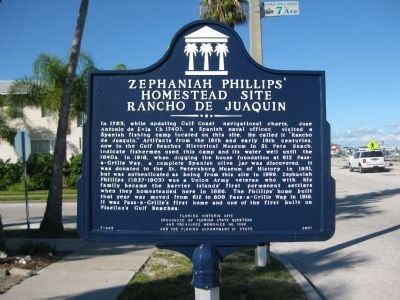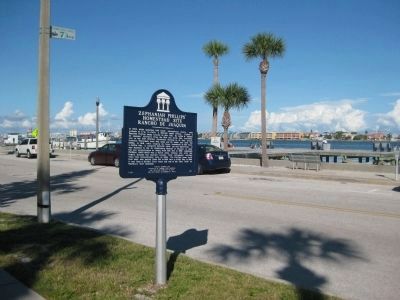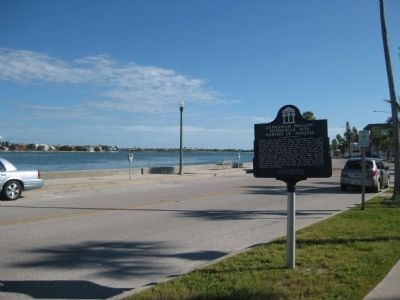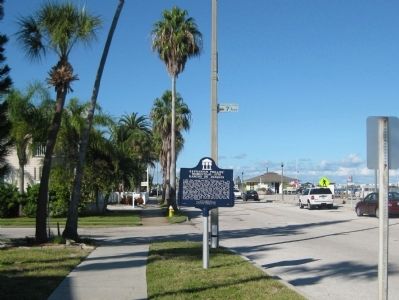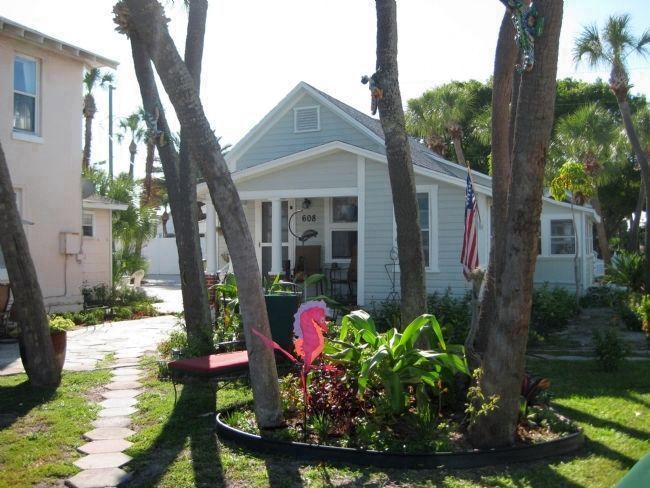St. Pete Beach in Pinellas County, Florida — The American South (South Atlantic)
Zephaniah Phillips' Homestead Site
Rancho de Juaquin
Inscription.
In 1783, while updating Gulf Coast navigational charts, Jose Antonio de Evia (b. 1740), a Spanish naval officer, visited a Spanish fishing camp located on this site. He called it “Rancho de Juaquin.” Artifacts from the 18th and early 19th centuries, now in the Gulf Beaches Historical Museum in St. Pete Beach, indicate fishermen used this camp and its water well until the 1840s. In 1918, when digging the house foundation at 612 Pass-a-Grille Way, a complete Spanish olive jar was discovered. It was donated to the St. Petersburg Museum of History in 1951, but was authenticated as being from this site in 1999. Zephaniah Phillips (1837-1903) was a Union Army veteran who with his family became the barrier islands’ first permanent settlers when they homesteaded here in 1886. The Phillips’ home built that year was moved from 612 to 608 Pass-a-Grille Way in 1918. It was Pass-a-Grille’s first home and one of the first built on Pinellas’s Gulf Beaches.
Erected 2001 by the Florida State Questers and Treasured Memories No. 1096 and the Florida Department of State. (Marker Number F-449.)
Topics. This historical marker is listed in this topic list: Settlements & Settlers. A significant historical year for this entry is 1783.
Location. 27° 41.227′ N, 82° 44.191′ W. Marker is in St. Pete Beach, Florida, in Pinellas County. Marker is at the intersection of Pass-a-Grille Way and 7th Avenue on Pass-a-Grille Way. The marker is located near the southern tip of Long Key, on the Pass-a-Grille Channel side of the island. It is across Pass-a-Grille Way from the 7th Ave. Fishing Pier. Touch for map. Marker is at or near this postal address: 608 Pass-a-Grille Way, Saint Petersburg FL 33706, United States of America. Touch for directions.
Other nearby markers. At least 8 other markers are within 5 miles of this marker, measured as the crow flies. "Pass-A-Grille" (approx. 0.2 miles away); Tierra Verde Mound (approx. 1.4 miles away); The Don Ce Sar Hotel (approx. 1.6 miles away); Gulfport Casino (approx. 3.9 miles away); Steven Jay Robin (approx. 4 miles away); Veterans Memorial (approx. 4 miles away); Osgood Point / Clam Bayou Nature Preserve (approx. 4.4 miles away); USCGC Blackthorn Bow Anchor (approx. 4.6 miles away). Touch for a list and map of all markers in St. Pete Beach.
More about this marker. The marker is capped with the Florida Historical Marker Program logo. It is located within the Pass-a-Grille Historic District (a National Historic District).
Regarding Zephaniah Phillips' Homestead Site. Pass-a-Grille Beach is the oldest beach resort community on Central Florida's west coast. According to
legend, it is thought that the name "Pass-a-Grille" is derived from the French Passe aux Grilleurs, or "passageway of the grillers", referencing the area's early history as a fishing camp, and the fisherman who used to grill their catch of the day on the shore.
After Zephaniah Phillips settled on Pass-a-Grille in 1886, others soon followed, and by the turn of the century the town had its first hotel and a ferry boat service to the mainland. The town of Pass-a-Grille Beach merged with other small communities on the island of Long Key to incorporate as the City of St. Petersburg Beach in 1957. The name was officially shortened to St. Pete Beach in 1994.
Also see . . . Biography of Zephaniah Phillips. with a family photo of Zephaniah and his wife Mary, and their children (Submitted on November 14, 2011, by Glenn Sheffield of Tampa, Florida.)
Credits. This page was last revised on April 10, 2018. It was originally submitted on November 14, 2011, by Glenn Sheffield of Tampa, Florida. This page has been viewed 2,279 times since then and 346 times this year. Photos: 1, 2, 3, 4, 5. submitted on November 14, 2011, by Glenn Sheffield of Tampa, Florida. • Bill Pfingsten was the editor who published this page.
